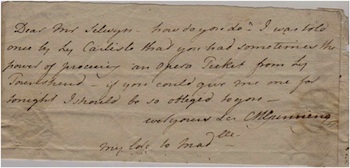

1. From George, 1st Lord Lyttleton.
2. From Rev John ‘Orator’ Henley.
5. From George James (‘Gilly’)Williams..
8. From Madame La Marquise de Stainville.
9. From Charles Townshend, n.d..
15. From Mr. Rogers
Selwyn 20: Letter from Maria Gunning, Countess of Coventry
Selwyn fell under the charms of Maria Gunning almost as soon as they met and their friendship continued throughout his life. Accordingly, there were many exchanges of correspondence, usually very cheerful and witty on both sides. There were, of course, the more serious ones if either party was trying to get information from the other, as in this case.
As with many letters of the time, the theme is one of using a friendship to obtain a favour etc, and this is very typical of such. Why did she not go direct to Lady Townshend, as they both moved in the same circles and already knew each other
Maria Coventry, Countess of Coventry (1733—30 September 1760) was a famous London beauty and society hostess during the reign of King George II, along with her sister Elizabeth. She was born Maria Gunning in Hemingford Grey, Huntingdonshire. Her mother was very ambitious for her two outstandingly beautiful daughters. However, the relative poverty of the family was against them and it seemed impossible to her that they would be able to make advantageous matches with rich men, so she decided that they should both become actresses. The two Gunning girls made their debut into high society in October 1748 when they attended Viscountess Petersham‘s ball at Dublin Castle. Their parents were too poor to be able to afford proper ball gowns so Thomas Sheridan, manager of the Theatre Royal in Dublin took pity on them and loaned them dresses from the theatre wardrobe. This was a very risky thing to do, but the girls were an instant and phenomenal success. They subsequently attained celebrity status and were mobbed everywhere they went. The two sisters were presented to George II at St James‘ palace on the 2nd December 1750 while the courtiers stood on chairs in order to gawp at them both and their social success seemed assured. All that was needed now was for them both to make amazing matches.
In the new year of 1752, Elizabeth Gunning was presented to the 6th Duke of Hamilton. He was instantly smitten with her blonde loveliness. They were both present at a ball at Bedford House just a month later and the young Duke, who was probably intoxicated in more ways than one, loudly and publicly declared his intention of making the blushing Elizabeth his bride and demanded that a parson be called for. The besotted couple jumped into a carriage and went off to Mayfair Chapel, for which a license was not required, and were married in secret.
Maria‘s wedding followed a month later, when she was married to the 6th Earl of Coventry. She and her husband went off to Paris for their honeymoon. However, the new Countess was rather less than fond of the French capital and pined for England, her unhappiness was made worse by the increasingly controlling behaviour of her husband who would not allow her to wear rouge and didn‘t think twice about publicly wiping it off her cheeks if she should appear with it on. When they finally returned to London, she was dismayed to find that her husband had taken as his mistress the equally beautiful Kitty Fisher. Maria was very upset by her husband’s unfaithfulness and began to take her own lovers in part out of loneliness but also, one feels, to get back at him.
Maria was to tragically die at the age of twenty seven on the 30th of September 1760, probably as a result of lead and arsenic poisoning from the heavy cosmetics that she liked to use, in defiance of her husband. The news of her death was greeted by widespread mourning and it is said that over ten thousand people turned up to see her coffin.
 Large image
Large image
The letter reads:
”Dear Mr Selwyn&emdash;how do you do? I was told once by Ly Carlisle that you had some times the power of procuring an Opera Ticket from Ly Townshend - if you could give me one for tonight I should be most obliged to you
ever yours &c [etc] M Gunning
My love to Madlle [Fagnani]
“